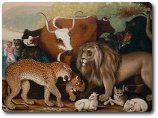The White Devil Contents
Animals
Animals and baseness
 According to the Elizabethan ‘chain of being', animals were the created order beneath humans, who were beneath the angels. (See The world of Shakespeare > making sense of the intangible world > Chain of being.) Thus animal imagery is used particularly to represent the baser aspects of humanity. There is an emphasis on sexuality and especially on women's lust.
According to the Elizabethan ‘chain of being', animals were the created order beneath humans, who were beneath the angels. (See The world of Shakespeare > making sense of the intangible world > Chain of being.) Thus animal imagery is used particularly to represent the baser aspects of humanity. There is an emphasis on sexuality and especially on women's lust.
Women
Women are referred to using animal names:
- In Act 3 sc 1 women are referred to as ‘conies' or rabbits
- In Act 5 sc 2 there is a reference to ‘geese' meaning prostitutes
- In Act 2 sc 1 ‘wild ducks' have a similar meaning.
Animal imagery often implies a sense that women's modesty is a mask to disguise unbridled lust, which is damaging to men. In Act 1 sc 2 Flamineo tries to persuade Vittoria to be more open to Brachiano's sexual advances when he says:
Even though it is Brachiano who is the seducer and Flamineo who is encouraging the seduction, it is here implied that Vittoria is to blame. The logical conclusion to this comes about when she tried after her husband's death on the charge of being a prostitute.
Women are accused of being even more dangerous and predatory when they are likened to wolves:
- Brachiano says to Vittoria:
Is either a god or a wolf.'(Act 4 scene 2)
- Flamineo refers to Zanche as a wolf when he says:
(Act 5 scene 1)
Does he love her or fear her more because of the hold she has over him?
Flamineo similarly shows his contempt for women when he compares his sister to a tortoise:
She must be turned on her back.'
(Act 4 scene 2)
He is thinking about Vittoria only in terms of her sexuality, which is probably true of most of the men in the play, despite the fact that she shows there is much more to her character.
Men
When animal imagery is used in association with men's sexuality it is to show their lack of sexual drive. Camillo, the wronged husband is spoken of as a cuckold. Cuckolds were traditionally supposed to sprout horns on their head. Camillo is fearful about his wife's faithfulness when he says:
Greater than these are shed.'(Act 2 scene 2)
Camillo is also referred to as a capon, which was a castrated cock and as a ‘dunghill bird' (a bird of carrion) who is easily defeated by a mightier eagle (Brachiano).
Recently Viewed
Scan and go
Scan on your mobile for direct link.